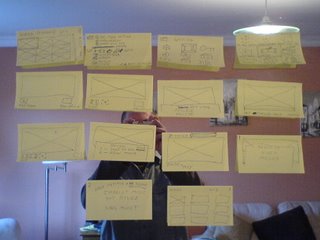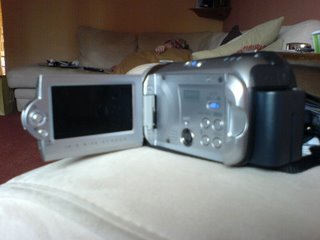Locative media is a truly location specific medium. It can bring users out of the office or classroom and deliver the spatial qualities of information to where they have relevance (space specific). Not only does it refer to all the information in the physical location but to other contextual cues as well.
Many of the various locative media projects researched have concentrated on social interaction with a place and with technology and have a social critical or personal background.
The types of technology that enable locative media are; (GPS) Global Positioning Systems, laptop computers, Palm computers (PDA’s) Personal Digital Assistants, Mobile Phones, Bluetooth and Satellite Navigation Software.
Whilst these technologies are the catalysts for locative media, they are not the goal for the development of projects in this area of research. Rather
"Locative media is many things: A new site for old discussions about the relationship of consciousness to place and other people. A framework within which to actively engage with, critique, and shape a rapid set of technological developments. A context within which to explore new and old models of communication, community and exchange. A name for the ambiguous shape of a rapidly deploying surveillance and control infrastructure." (Russell, 2004)
Context-aware computing represents a relatively new area of research. Context awareness means gathering information from the environment to provide a measure of what is currently going on around the user and the device. Activities and content that are particularly relevant to that environment can then be made available. Mobile devices are especially well suited to context-aware applications simply because they are available in
different contexts, and so can draw on those contexts to enhance the learning activity. Context-aware mobile devices can support learners by allowing a learner to maintain their attention on the world and by offering appropriate assistance when required.
The museum and gallery sector has been on the forefront of context-aware mobile computing by providing additional information about exhibits and displays based on the visitor’s location within them.
Thursday, November 02, 2006
User Centre Design-Flash Prototype

Notes from Tuesday Needs and requirements-users-redesign.
Stages
Identify, data collection and analysis, capture.
VOLERE TEMPLATE
Requirements
Tunctional/Env/User/Usability/Data
Prototyping
Paper, storyboards,screenshots
Horizontal-Look of homepage
Vertical-Functions behind the homepage
Screenshots of development of Flash prototype and progress sheet from Wednesday





Tuesday, October 31, 2006
The Big Welsh Challenge
Today Stephen Morgan from BBC Online and Education department came to the lab to test a new Broadband Broadcasting development.
We acted as guinea pigs helping the BBC test their latest development ( as part of The Big Welsh Challenge) This helped give us an inside look at how the BBC go about getting user feedback and testing their prototypes.
I guess it's aimed at teenagers upwards to be used as an alternative to the more cartoonish welsh learning site on the Beeb - Colin & Cumberland
Partitipation session notes
Web 2.0, stumbleupon.com, delicious, useit, sitepoint.com, istumbler-bluetooth
http://dfim-ccs.blogspot.com/2006/10/seminar-four-participation.html
session 5 location aware services/locative media
software and systems that are aware of their locations. Google-earth-maps-multimap. Tom Tom how do they use maps.
Follow Taff Trial no these maps
phones know where they are so you can ask for services near it eg cinemas, banks
Commercial services
Locative media - art term
"The shape of locative media" MUTE by Simon Pope
GPS-Smartphones services
HP USA
Create-a-scape
How stuff works phone technology
Japanese phone GPS
Schengen zone at airports
degree confluence project.
http://dfim-ccs.blogspot.com/2006/10/session-five-location-aware-services.html
http://dfim-ccs.blogspot.com/2006/10/seminar-four-participation.html
session 5 location aware services/locative media
software and systems that are aware of their locations. Google-earth-maps-multimap. Tom Tom how do they use maps.
Follow Taff Trial no these maps
phones know where they are so you can ask for services near it eg cinemas, banks
Commercial services
Locative media - art term
"The shape of locative media" MUTE by Simon Pope
GPS-Smartphones services
HP USA
Create-a-scape
How stuff works phone technology
Japanese phone GPS
Schengen zone at airports
degree confluence project.
http://dfim-ccs.blogspot.com/2006/10/session-five-location-aware-services.html
Sunday, October 29, 2006
DfIM Assignment 1: Reading a Research Paper
Research Area of Interest - Locative Media
Paper for Evaluation
Examining Mobile Phone Use In The Wild With Quasi-Experimentation.
The motivation for this work is for commercial (funded by Nokia Corporation) research into how users interact with mobile devices and they environment around them on the go as opposed to in a laboratory environment. One problematic issue has been that current methods are not suited for attempting to establish causal relationships between context variables and interaction. In the paper they describe an experimental method, called quasiexperiment, and apparatus for recording mobile phone usage and the environment in a mobile context.
The proposed solution for recording people’s interactions with mobile devices (in this case web browsing on a mobile phone) is to use a series of miniature cameras set up to record;
• The user’s face and eyes
• The phone display and keys
• The environment as seen from the users point of view
• The user and environment as seen by a moderator
Two of the cameras are attached to the phone, another is attached to the shoulder of the user, and the fourth is carried by the modulator disguised as a mobile phone. Images from the four different cameras are combined into one and time coded together to produce a complete record of the users interaction.
In terms of the evaluation of the proposed solution to recording mobile phone use in the wild, they conclude that their portable apparatus allowed them to gather multi-variable data from the different mobile contexts, and that no other study has captured as much data with such a wide range of variables.
They felt that their method would be suitable for other field experiments where device interaction and/or user behaviour and the environment have to be examined.
They claim to have managed to root out relevent and scientifically reliable data about user behaviour in the mobile context. So in terms of purpose they felt the research was a success.
I was persuaded of the merits of the proposed solution in that I agree that putting all 4 camera views together and having the time codes sync up would lend to you gathering all the relevent data you could get from the users interacting with the device. But I do feel that when people on the street question the users about what they are doing, this acts as an unwanted distraction and outside influence that could affect the results.
The future directions for this type of research is primarily to have more easily operated portable, light equipment to be able to record events and environmental circumstances automatically, thus minimizing the need for manual coding and time logging of data collected, which would make it less laborious and time consuming.
Because of cost constraints no portable eye tracking equipment was used in the experiments. Use of this technology in future experiments could provide useful extra data concerning eye movement and attention of the user.
The writers of the paper “hope that future work will hopefully be able to provide better and lighter-weight methodology for system developers and other practitioners to evaluate and examine their applications in the wild”. As I’ve said earlier this method of date collection would lend itself very easily to other field experiments using mobile devices.
While reading and re-reading the paper there were a few things that I didn’t understand:
• I didn’t know that quasi meant “used to show that something is almost, but not completely, the thing described”
• They didn’t explain their reasons for not telling the participants the real purpose of the experiment until the end of their participation.
• I didn’t understand what [Low Experimental Power “experiments in the world are susceptible to low power” page 13] meant.
• I didn’t understand what [The Reliability of Measures “Measures of low reliability may not register true change” page 13] meant.
Bibliography
Virpi Roto, Antti Oulasvirta, Tuulia Haikarainen, Jaana Kuorelahti, Harri Lehmuskallio, Tuomo Nyyssonen. (2004). Examining Mobile Phone Use In The Wild With Quasi-Experimentation. [online].
Available from: http://www.hiit.fi/publications/pub_files/hiit2004-1.pdf
[Accessed 15 Oct 2006]
Gaetano Borriello, Matthew Chalmers, Anthony LaMarca, Paddy Nixon. (2005). Delivering Real-World Ubiquitous Location Systems. [online].
Available from: http://www.lazowska.cs.washington.edu/gb.pdf
[Accessed 17 Oct 2006]
Anne Galloway, Carleton Matthew Ward. (2005). Locative Media As Socialising And Spatialising Practices: Learning From Archeology [online].
Available from http://www.purselipsquarejaw.org/papers/galloway_ward_draft.pdf
[Accessed 17 Oct 2006]
Paper for Evaluation
Examining Mobile Phone Use In The Wild With Quasi-Experimentation.
The motivation for this work is for commercial (funded by Nokia Corporation) research into how users interact with mobile devices and they environment around them on the go as opposed to in a laboratory environment. One problematic issue has been that current methods are not suited for attempting to establish causal relationships between context variables and interaction. In the paper they describe an experimental method, called quasiexperiment, and apparatus for recording mobile phone usage and the environment in a mobile context.
The proposed solution for recording people’s interactions with mobile devices (in this case web browsing on a mobile phone) is to use a series of miniature cameras set up to record;
• The user’s face and eyes
• The phone display and keys
• The environment as seen from the users point of view
• The user and environment as seen by a moderator
Two of the cameras are attached to the phone, another is attached to the shoulder of the user, and the fourth is carried by the modulator disguised as a mobile phone. Images from the four different cameras are combined into one and time coded together to produce a complete record of the users interaction.
In terms of the evaluation of the proposed solution to recording mobile phone use in the wild, they conclude that their portable apparatus allowed them to gather multi-variable data from the different mobile contexts, and that no other study has captured as much data with such a wide range of variables.
They felt that their method would be suitable for other field experiments where device interaction and/or user behaviour and the environment have to be examined.
They claim to have managed to root out relevent and scientifically reliable data about user behaviour in the mobile context. So in terms of purpose they felt the research was a success.
I was persuaded of the merits of the proposed solution in that I agree that putting all 4 camera views together and having the time codes sync up would lend to you gathering all the relevent data you could get from the users interacting with the device. But I do feel that when people on the street question the users about what they are doing, this acts as an unwanted distraction and outside influence that could affect the results.
The future directions for this type of research is primarily to have more easily operated portable, light equipment to be able to record events and environmental circumstances automatically, thus minimizing the need for manual coding and time logging of data collected, which would make it less laborious and time consuming.
Because of cost constraints no portable eye tracking equipment was used in the experiments. Use of this technology in future experiments could provide useful extra data concerning eye movement and attention of the user.
The writers of the paper “hope that future work will hopefully be able to provide better and lighter-weight methodology for system developers and other practitioners to evaluate and examine their applications in the wild”. As I’ve said earlier this method of date collection would lend itself very easily to other field experiments using mobile devices.
While reading and re-reading the paper there were a few things that I didn’t understand:
• I didn’t know that quasi meant “used to show that something is almost, but not completely, the thing described”
• They didn’t explain their reasons for not telling the participants the real purpose of the experiment until the end of their participation.
• I didn’t understand what [Low Experimental Power “experiments in the world are susceptible to low power” page 13] meant.
• I didn’t understand what [The Reliability of Measures “Measures of low reliability may not register true change” page 13] meant.
Bibliography
Virpi Roto, Antti Oulasvirta, Tuulia Haikarainen, Jaana Kuorelahti, Harri Lehmuskallio, Tuomo Nyyssonen. (2004). Examining Mobile Phone Use In The Wild With Quasi-Experimentation. [online].
Available from: http://www.hiit.fi/publications/pub_files/hiit2004-1.pdf
[Accessed 15 Oct 2006]
Gaetano Borriello, Matthew Chalmers, Anthony LaMarca, Paddy Nixon. (2005). Delivering Real-World Ubiquitous Location Systems. [online].
Available from: http://www.lazowska.cs.washington.edu/gb.pdf
[Accessed 17 Oct 2006]
Anne Galloway, Carleton Matthew Ward. (2005). Locative Media As Socialising And Spatialising Practices: Learning From Archeology [online].
Available from http://www.purselipsquarejaw.org/papers/galloway_ward_draft.pdf
[Accessed 17 Oct 2006]
Subscribe to:
Comments (Atom)


